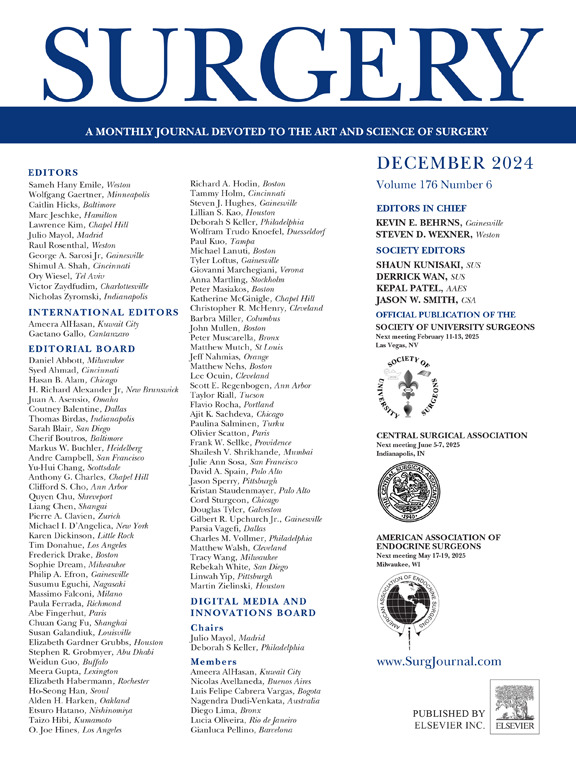SHapley Additive exPlanations (SHAP)-based, multivariate machine-learning techniques with external validation: Construction of a preoperative interpretable predictive model for intestinal resection of incarcerated inguinal hernia
IF 3.2
2区 医学
Q1 SURGERY
引用次数: 0
Abstract
Background
Currently, there are a lack of effective tools for preoperative risk assessment of intestinal resection in patients with inguinal incarcerated hernia. The purpose of this study is to investigate the variable characteristics associated with intestinal resection and develop an interpretable preoperative prediction model, aiming to assist clinicians in preoperative risk for intestinal resection in patients with inguinal incarcerated hernia.
Methods
The data from 2 medical institutions were retrospectively collected, and they were grouped according to whether intestinal resection was performed intraoperatively and the pathologic results. Lasso and multifactor logistic regression screened variables, and 10 machine-learning algorithms built and validated the model, with evaluation using the confusion matrix and SHapley Additive exPlanations value.
Results
Lasso regression and multifactorial logistic regression analyses showed that peritonitis, intestinal obstruction, neutrophil count, C-reactive protein, and preoperative total protein were the key characteristic variables. The area under curve of models constructed by 10 algorithms in the external validation set were all above 0.8, and the k-nearest neighbor algorithm had the most comprehensive model performance. The constructed model exhibits good predictive performance on the external validation set.
Conclusion
Accurate preoperative prediction of intraoperative intestinal ischemia in patients with incarcerated inguinal hernia is crucial. This study identified peritonitis, intestinal obstruction, neutrophil count, C-reactive protein, and preoperative total protein as characteristic variables for predicting intraoperative intestinal ischemia in these patients. The constructed prediction model can assist clinicians in more accurately assessing intestinal viability during surgery, offering valuable insights for evaluating intestinal resection risk.

基于SHapley加性解释(SHAP)的多变量机器学习技术与外部验证:构建嵌顿腹股沟疝肠切除术的术前可解释预测模型
背景目前,腹股沟嵌顿疝患者肠切除术的术前风险评估缺乏有效的工具。本研究的目的是探讨肠切除术相关的可变特征,建立可解释的术前预测模型,旨在帮助临床医生了解腹股沟嵌顿疝患者术前肠切除术的风险。方法回顾性收集2家医疗机构的资料,根据术中是否行肠切除术及病理结果进行分组。Lasso和多因素逻辑回归筛选变量,并使用10种机器学习算法构建和验证模型,使用混淆矩阵和SHapley加性解释值进行评估。结果slasso回归和多因素logistic回归分析显示,腹膜炎、肠梗阻、中性粒细胞计数、c反应蛋白和术前总蛋白是主要特征变量。外部验证集中10种算法构建的模型曲线下面积均在0.8以上,其中k近邻算法的模型性能最全面。所构建的模型在外部验证集上表现出良好的预测性能。结论术前准确预测嵌顿腹股沟疝患者术中肠缺血至关重要。本研究确定腹膜炎、肠梗阻、中性粒细胞计数、c反应蛋白和术前总蛋白作为预测这些患者术中肠缺血的特征变量。构建的预测模型可以帮助临床医生更准确地评估手术中肠道活力,为评估肠道切除风险提供有价值的见解。
本文章由计算机程序翻译,如有差异,请以英文原文为准。
求助全文
约1分钟内获得全文
求助全文
来源期刊

Surgery
医学-外科
CiteScore
5.40
自引率
5.30%
发文量
687
审稿时长
64 days
期刊介绍:
For 66 years, Surgery has published practical, authoritative information about procedures, clinical advances, and major trends shaping general surgery. Each issue features original scientific contributions and clinical reports. Peer-reviewed articles cover topics in oncology, trauma, gastrointestinal, vascular, and transplantation surgery. The journal also publishes papers from the meetings of its sponsoring societies, the Society of University Surgeons, the Central Surgical Association, and the American Association of Endocrine Surgeons.
 求助内容:
求助内容: 应助结果提醒方式:
应助结果提醒方式:


